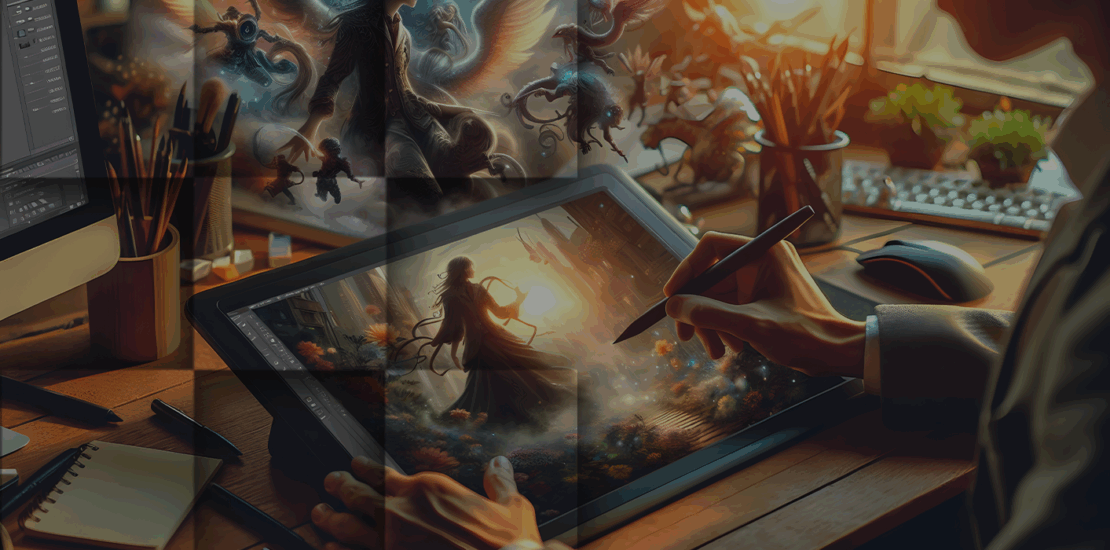Expanding Creativity with AI: The Future of Game Art Pipelines
- September 10, 2025
- Posted by: iXie
- Category: Game Art

What if the most valuable thing AI gives us in 2025 isn’t more art, but more time?
Instead of asking “Will AI replace artists?”, the teams that ship game art ask, “Where can AI help without hurting our style?” The best teams use AI to support the overall look and feel: it cuts waiting, removes busywork, and gives artists more time to focus on how the game looks, feels, and tells its story.
Don’t think of the pipeline as a magic button. Instead, think of it as a power suit for artists. It’s a set of safe tools inside the art apps you already use, tracked with version control and guided by a living style guide.
The result: faster ideas, smarter asset reuse, checks that catch problems before a build, and in-game visuals that adjust to the moment, all with people in charge. The big idea is teamwork, and the proof is quick iteration. Next, we focus on making the jump from a good idea to a great one as small as possible.
Contents
Idea-to-Iteration in Minutes
Concept phases used to bottleneck on the calendar: mood boards, thumbnails, buy-in, then variants. Generative tools compress that loop. The trick isn’t “generate more,” but “generate closer.”
What that looks like in practice
- Style locks before prompts. Codify brushwork, values, materials, and palette per biome; reuse prompt packs + refs so passes converge.
- Image-to-image over text-only. Run sketches/grayboxes through guided masks to preserve silhouette, perspective, and focal points.
- Seed discipline & versioning. Fix seeds, branch like code, and annotate intent (e.g., dusk tone, HUD readability).
- Low-fidelity first. Block values/shapes; raise fidelity only for shortlisted routes. Artists overpaint/photobash/paint back to final.
You can turn a desert outpost into a rainforest listening post, or even an arctic relay station, in one morning and still keep the game’s look and feel. You’re not giving up creative control; you’re just exploring ideas faster.
But quick ideas only help if the assets keep up. Once the sketch is set, the next boost comes from finding existing pieces fast and tweaking them rather than rebuilding everything from scratch.

Smart Asset Libraries
Most studios already have big folders of 3D models, textures, and props. The hard part is finding the right one and making it fit a new art style. AI turns those messy folders into a searchable library and helps restyle assets, so you don’t have to rebuild them from scratch.
- Semantic search: tag by shape/function/motif and feel (ornate, brutalist, cozy) so “find small sci-fi kiosks with slanted panels and exposed cabling” becomes a natural query.
- Style retargeting: learned adapters re-skin meshes across aesthetics while preserving structure and Texel density targets.
- Parametric materials & trims: propose trim-sheet assignments and generate worn/clean, wet/dry, winter/summer variants aligned to engine budgets.
- Ingest checks: automatic UV/LOD/padding validation so assets are “drop-in safe.”
It’s not about making every game look the same. It’s about reusing the right pieces. Spend your creative time on new shapes, standout props, and story details, and let the asset library supply the solid base parts you can quickly restyle.
Making more art shouldn’t mean more mistakes. As the library helps you produce faster, your quality checks need to keep up. Use visual AI checks early so you catch issues before they reach a build.

From Manual QA to Visual Intelligence
Art QA used to be mostly manual, with people staring at screenshots and bug lists and guessing at issues like a flipped normal map. Now visual intelligence runs those checks automatically and provides clear, measurable results before the build.
What can be checked automatically
- Topology & bakes: non-manifold, ngons, hard/soft edges, cage/low mismatches.
- UV & Texel density: overlaps, padding, variance; auto-flag out-of-spec TD.
- Material compliance: PBR ranges, metal/rough correlations, channel packing, platform limits.
- Scene linting: naming, layers, LODs, pivots, scale, collision.
- Render diffs: golden-image regressions (lighting, shadow acne, AO, Z-fighting).
- Perception checks: UI contrast, color-blind safety, silhouette read at gameplay distances.
People still decide when to break the rules on purpose. But if the pipeline does the first check, artists see clear alerts instead of hunting for problems. That means fewer last-minute rushes, cheaper fixes, and better performance.
Once assets are clean and QA is tight, the question becomes less “how fast can we make art?” and more “how alive does it feel?” The next step is letting the world react to players while keeping the game’s signature look.
Dynamic Aesthetics
The next step is not just making art faster, but making art respond. AI tools can change the visuals to match the moment without losing the game’s style.
- Adaptive environments: decals, debris, foliage, and weathering respond to player actions/world state.
- Personalized readability: contrast, outlines, and color ramps tune per player/telemetry within author-set bounds.
- Narrative set dressing: lightweight generative passes vary props/signage by faction, economy, or season.
- Performance-aware rendering: auto-pick material LODs/effect swaps to hit FPS without breaking the look.
Keep things predictable, with no random visual changes. Set clear limits so the style doesn’t drift and make the rules easy to see so designers know what changed and why.
You’re improving the world, not leaving it to chance. AI can adapt the art, but human taste stays in charge. Use guardrails that protect the artist’s intent while AI does the heavy lifting.
Keeping the Human Touch
It’s true that AI can flatten a style. You prevent that by being intentional.
- Style bible as code. Treat the guide as a living schema (palettes, value bands, brushwork, texture-noise ceilings, biome/material rules, camera language) that tools ingest first.
- Provenance & permission. Train only on licensed data, log inputs/outputs, avoid black-box models for shipped content.
- Human sign-offs. Gates for key art, hero props, biome masters, and faces. AI proposes, and humans publish.
- Originality checks. Run nearest-neighbor scans; if a piece echoes known work, repaint.
- Upskill the team. Artists: prompts/control flows. TDs: sandboxes/compute isolation. Producers: budget AI iterations.
People create the vision, not AI. AI just helps you deliver that vision faster and more consistently, as long as you stay in control.
Ideas are good, but shipping is better. Here’s how we put that balance into practice without losing craft, performance, or control.

iXie’s Role
We use AI to make game art faster and more consistent, without losing style. Our team covers concept art, 2D/UI, 3D, VFX, and lighting, and can plug in at any stage of your pipeline. Bottom line: your vision, ready for the game.
Where we plug in
- Concept co-pilot sprints: style-locked ideation, then artist paint-back to final.
- Library intelligence: semantic tags + health checks (UVs, LODs, materials) for fast reskin/retarget.
- Visual QA harness: automated topology, PBR, Texel-density, scene lint; render diffs catch regressions.
- Dynamic aesthetic prototypes: guarded runtime rules (materials, decals, set dressing) that keep VFX/lighting on brand.
How we work
Blueprint (audit and metrics), then Pilot (prove the loop), then Scale (train, govern, and dashboard).
Principles
Artist-first • Secure by design • Engine-aware (Unreal, Maya, ZBrush).
Proof
550+ titles shipped • Broad portfolio across characters, environments, props • Fits modern pipelines.
Net result
Make more game ready art, with fewer last-minute problems and a more consistent look. Start small and run a short test project instead of a big launch.
Where to Start (and What to Avoid)
If you’re building this into your pipeline, start small and intentional:
- Pick one pain point, such as concept exploration, asset search, or QA, and measure before and after.
- Turn your style guide into a schema. Define numeric bounds where possible; AI loves constraints.
- Curate your dataset. Remove deprecated assets and unclear rights. Quality in, then quality out.
- Wire in version control and approvals. Treat AI outputs like code commits, not chat logs.
- Budget compute. Batch jobs (bakes, checks) off-peak; keep interactive tasks snappy for artists.
Pitfalls to dodge
- Chasing novelty tools weekly; pick stable, scriptable ones and evolve them.
- Letting AI outputs drift into builds without human review.
- Ignoring accessibility and readability in the name of “style.”
- Over-personalizing visuals until players can’t share a common look and feel.
Big picture: set guardrails and build good habits, and AI stops being a gimmick and starts getting real work done.
The Bottom Line
AI isn’t here to replace an artist’s vision or a director’s taste. It’s here to cut wasted time, reduce boring rework, and stop the hunt through messy files. In 2025, the best studios aren’t the ones with the flashiest tech, but the ones with clear rules and good habits. The future is artists and AI working together, not against each other.
Want to see this in your pipeline? Start with a small pilot. It’s the quickest way to show real benefits and reduce risk. Whether you’re running a live-service game or building a new IP, set clear rules and track a few key numbers. That’s how you get a pipeline that moves faster and makes better art.

